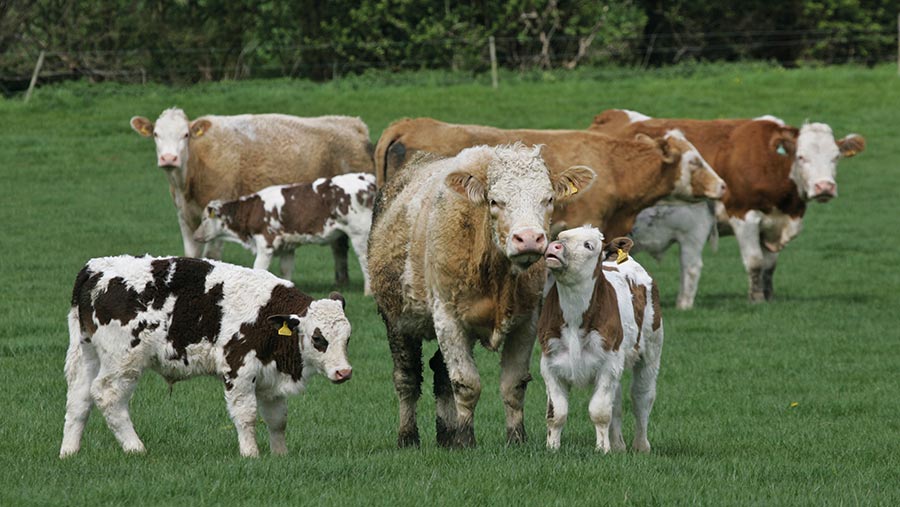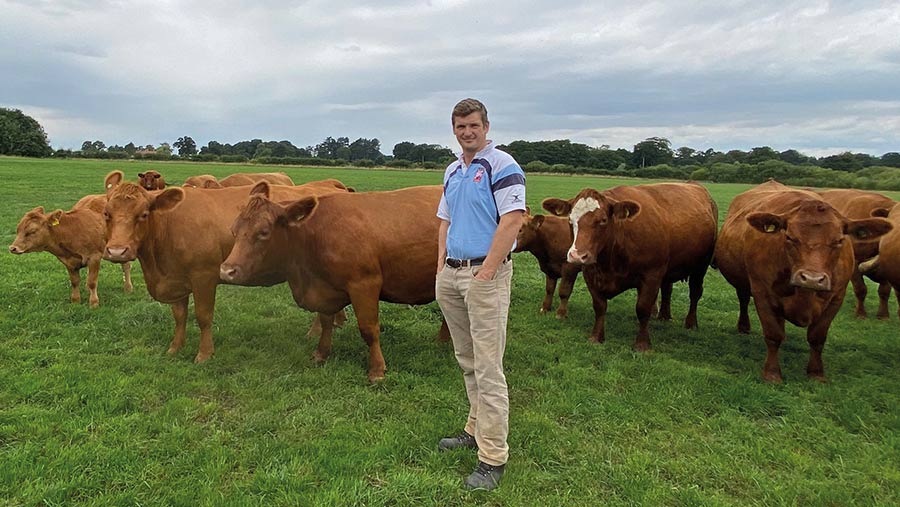5 KPIs to measure to improve suckler herd performance
 © Tim Scrivener
© Tim Scrivener With the changes in agricultural payments around the corner, there has never been a more appropriate time to focus on maternal key performance indicators (KPIs) and your cost of production (COP).
Suckler herds will have to evolve to overcome the challenges ahead, and concentrating on maternal attributes has been proven to increase profitability.
Improvements in fertility traits can have five times the economic benefit of improvements in growth and carcass traits.
Only 82% of suckler cows produce a calf each year and the average age at first calving is 32.8 months in the UK, as opposed to the recommended 24 months.
See also: How to ensure heifers calve at two years old
Only 35% of suckler herds calve at two years and the average suckler producer is losing £135 a cow a year before subsidy.
These statistics put us behind our global competitors in terms of maternal efficiency.
So, which KPIs should suckler producers concentrate on to improve business performance? We take a closer look.
1. Cost of Production (COP) a calf weaned
Knowing your COP allows you to make informed marketing and business decisions. An accurately calculated COP can also be used to benchmark yourself against similar enterprises and identify areas where your spending or income may be above or below average.
COP can be calculated using the AHDB KPI Express tool (see farmbusinessreview.ahdb.org.uk) and requires knowledge of business income and expenditure.
2. Age at first calving
Reducing age at first calving is a proven and effective way of reducing COP and increasing cow lifetime performance. Replacements account for 8.5% of COP, so can you really afford not to calve heifers at two years?
Target:
Calve at 22-26 months for maximum efficiency.
How to improve:
While many factors contribute to successfully calving at two years, hitting target bulling weights is essential to ensure puberty is reached early enough and heifers calve easily. Good nutrition and selecting for positive 200-day and 400-day growth can be achieved using estimated breeding values (EBVs).
3. Cow herd efficiency
This assesses the relationship between cow weight and calf output. It is linked to profitability and reflects herd fertility, health, genetics, feed, and management.
To calculate it you need an average liveweight of calves at weaning, an average liveweight of females put to the bull, and your average age at weaning (in months).
Target:
A cow should wean 40%-60% of her liveweight in calves.
How to improve:
Pay close attention when selecting female replacements. Keeping records of their mothers’ abilities will make selection easier.
Careful choice of a bull for breeding replacements is also vital. Milk EBV, mature cow weight EBV, and 200-day growth EBV are all important, while always looking for easy calving.
4. Females calved in first six weeks
A tight calving block indicates good fertility and makes management easier, resulting in calves that are more consistent at weaning, easier to market, and can be effectively managed in a block.
Target:
The aim is for more than 65% of the herd to calve within the six-week window. Anything above 80% is excellent.
How to improve:
The feeding, grouping, and general management of cattle have a huge impact on fertility. Nutrition pre-calving is equally important post-calving.
Body condition score is a good indicator of energy status. Ask your vet to take blood samples if you think mineral deficiency may be an issue.
Minimise stress around bulling and during the following weeks to improve conception rates, and consider keeping heifers in a separate management group right through to second calving.
5. Daily liveweight gain (DLWG) of calves to weaning
With the right genetics, the dam’s ability to milk, and correct grassland management, calves should grow well.
It is important that this is achieved cost-effectively, and if higher rates of growth can only be achieved with increased inputs, COP must be considered carefully.
Weigh calves at weaning to calculate this KPI. Divide the average weight gain from birth to weaning by the average age of calves at weighing.
Target:
Calves should average at least 1.1kg/day from birth to weaning.
How to improve:
Young calves are the most feed-efficient animals on the farm, so make the most of this.
Good-quality colostrum is essential in a suckler system, and this can be achieved by getting cow nutrition right through pregnancy.
Ensuring cows have good milking ability through genetics and nutrition will make the most of those early feed conversion rates. Good feed quality is key, be that grass or forage.
This applies not only to the cow, but the calf as well. By four months of age, only half its feed requirements are met by milk.
Case study: Eddie Rook, East Yorkshire

© Eddie Rixon
Yorkshire beef farmer Eddie Rook calves his herd of 200 Stabiliser cattle over a nine-week period with 82% of females calving in the first six weeks.
He uses KPIs to track his herd’s performance.
“You could spend a lot of time collecting data and never use it, so picking a few main KPIs to focus on makes it easier to see how improvements can be made,” he says.
Mr Rook’s cow efficiency averages 48.7%, which is bang on target. But he would still like to improve this further. Heifers are calved at two years to ensure they repay their rearing costs as quickly as possible.
“One of the biggest costs associated with any suckler herd is heifer rearing. They need to calve at two years to start paying their way.”
Mr Rook aims for his heifers to weigh between 380-410kg at bulling.
“Our heifers get the best of the grass that’s available. We rotationally graze to make sure that grass keeps growing as long as possible and retains a high level of nutrients.
“We choose bulls on their EBVs and structural soundness and often use an AI bull on our heifers to make sure they calve easily.”
Maternal Matters
This content has been produced as part of Farmers Weekly and AHDB’s new Maternal Matters series.
Maternal Matters is an AHDB initiative putting a spotlight on the importance of maternal performance in driving profitability in the suckler herd.
As part of the series, we will be bringing you regular articles on how to improve the efficiency of your suckler herd, including:
- How improved maternal performance reduces costs
- Using maternal genetics to breed profitable females
- Calving heifers at two years to reduce cost of production
- Reducing calf losses
- Heifer management for rebreeding success.
Find out more at ahdb.org.uk/maternal-matters
To calculate all the KPIs mentioned in this article and to see how your farm compares, use the AHDB KPI tool at farmbusinessreview.ahdb.org.uk
Join the AHDB webinar on Thursday 23 September which focuses on profitability in the suckler herd in more detail ahdb.org.uk/events/suckler-profit-drivers-and-cost-savers-where-to-focus.
